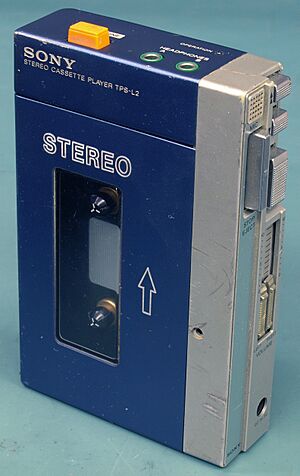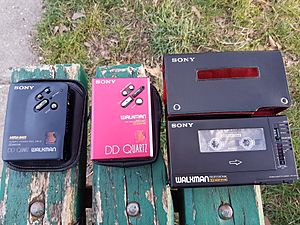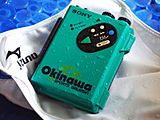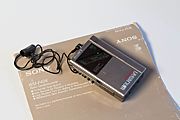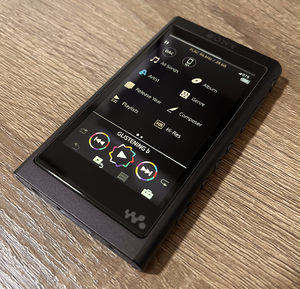Walkman facts for kids

Walkman logo since 2000
|
|
|
Left to right from top: an (original) cassette Walkman (1980s), a CD Walkman (2001), an MD Walkman (1998), a digital Walkman (2011)
|
|
| Manufacturer | Sony |
|---|---|
| Type | Portable media player Released: 1979 Japan, 1980 U.S. |
| Retail availability | July 1, 1979 – October 25, 2010 (Compact Cassette player) |
| Units sold | 385 million (all editions, as of March 31, 2009) |
| Related articles |
|
The Walkman (pronounced WALK-man) is a famous brand of portable music players. It was created by the Japanese company Sony in 1979.
The very first Walkman was a small cassette player. It let people listen to music using headphones while they were out and about. It became so popular that many people started calling any portable cassette player a "Walkman," no matter who made it!
Over time, the Walkman brand grew. It included players for DATs, MiniDiscs, and CDs. Later, it also covered transistor radios, mobile phones, and digital music players. Today, the Walkman brand is only used for digital music players.
In 2023, Sony released new Walkman models, like the NW-A306 and NW-ZX707. These new players offer better sound and longer battery life.
Contents
How the Walkman Was Made
The Compact Cassette was invented in 1963 by a Dutch company called Philips. By the late 1960s, you could buy pre-recorded cassettes. This made it possible to listen to music in cars or on small portable devices. However, records were still the most popular way to listen at home.
Before the Walkman, there were portable tape players. But they weren't really designed for people to use while walking. In the 1970s, an inventor named Andreas Pavel had an idea for a player you could wear. He called it the "Stereobelt." However, his idea didn't have the special technology needed for good sound quality while moving.
Sony co-founder Masaru Ibuka loved listening to music. He used a big Sony cassette recorder when he traveled for work. He asked Norio Ohga, another Sony executive, to create a smaller, lighter stereo player. This new player would be perfect for listening while walking.
The first Walkman, called the TPS-L2, was blue and silver. It was the world's first affordable personal stereo. It went on sale in Japan on July 1, 1979. It cost about ¥33,000 (around $150 at the time). Sony thought they would sell about 5,000 units a month. But they sold over 30,000 in just two months!
The Walkman soon launched in other countries. At first, it had different names, like Sound-about in the US and Stowaway in the UK. But by the early 1980s, the name Walkman became famous worldwide. Sony then used this name everywhere.
The 1980s were a big time for Walkman improvements. In 1981, Sony released the WM-2, which was much smaller. In 1982, they added a radio to some Walkman models. They also added Dolby noise-reduction system to make the sound clearer.
In 1983, the super-small WM-20 came out. It was about the size of a cassette tape and had a special case that made it easy to carry. In 1984, the first Walkman with "autoreverse" was released. This meant you didn't have to flip the tape over to listen to the other side.
By 1989, just 10 years after it first came out, over 100 million Walkmans had been sold! By 1999, 20 years later, Sony had sold 186 million cassette Walkmans.
Later, compact disc players became popular. This led to fewer cassette Walkmans being sold. The last cassette Walkman was stopped in Japan in 2010.
How the Walkman Was Advertised
The way Sony advertised the Walkman helped share Japanese culture around the world. It showed how Japan was good at making small, high-tech things. Sony even hired young people to walk around in public wearing a Walkman. They would let others try it out.
A big part of the Walkman's advertising was showing how it was special. Before the Walkman, portable music usually came from a radio. With a Walkman, you could choose your own music. This was a new and exciting way to listen. People could pick the perfect Walkman for them, with different features and styles. This made people feel like the product was made just for them.
Walkman's Big Impact
The Walkman changed how people listened to music. It became a huge part of the 1980s culture. In 1986, the word "Walkman" was added to the Oxford English Dictionary.
Millions of people started using the Walkman while exercising. This helped kick off the aerobics craze. Between 1987 and 1997, the number of people who walked for exercise went up by 30%! Other companies like Aiwa and Panasonic also started making similar products.
The Walkman also changed how people thought about technology. It was a "personal" device, letting users listen to their own music privately. It was like an early version of personal computers or mobile phones. People also started wearing headphones in public more often.
The Walkman's success also made the Compact Cassette very popular. Soon, more cassettes were sold than vinyl records. This continued until compact discs (CDs) became more popular in 1991.
In some countries, like Germany and Austria, "Walkman" became a general word for any personal stereo. This shows how famous the brand became.
In 2019, a large statue of a Sports Walkman FM was put up in Tokyo. This was to celebrate the Walkman's 40th birthday!
Other Walkman Models
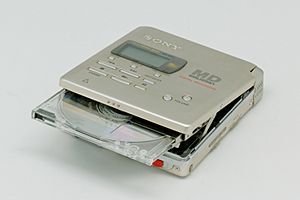
The Walkman brand expanded beyond cassette players.
- In 1989, Sony released portable Video8 recorders called Video Walkman.
- In 1990, portable Digital Audio Tape (DAT) players were called DAT Walkman.
- In 1992, MiniDisc players were named MD Walkman.
- From 1997, Sony's portable CD players, once called Discman, were renamed CD Walkman.
- By 2000, all Walkman products used a new small "W." logo.
Digital Players (1999–Present)
On December 21, 1999, Sony launched its first digital audio players (DAP). They were called Network Walkman. These players often used Memory Sticks or built-in flash memory. They also had special copyright protection. At first, they only played Sony's own ATRAC music format, not common MP3 files.
Sony also made Walkman-branded mobile phones with Sony Ericsson.
However, Sony didn't have the same success with digital Walkmans as they did with cassette players. Apple's iPod became very popular. The Network Walkman struggled against rivals like Creative and iRiver. Its high price and lack of MP3 support in early years were some reasons.
Even so, the Walkman brand is still around today. It focuses on digital audio and media players.
Current Walkman Models
Today, Walkman portable digital audio players are the only products still made under the Walkman brand. Their model numbers still start with "NW-". As of 2022, the current models include:
- A Series – These are mid-range players.
- B Series (outside Japan) – These are smaller, budget-friendly music players.
- E Series – These are entry-level players.
- S Series (Japan) – These are also entry-level players.
- W/WS Series – These are music players you can wear.
- WM1 Series – These are very fancy, high-end players.
- ZX Series – These are high-end music players.
Since 2017, Sony also offers a computer program called Music Center for PC. It helps you transfer and play music on your Walkman and other Sony audio devices.
See also
 In Spanish: Stereo personal para niños
In Spanish: Stereo personal para niños
- Walkman effect
- Stereobelt
- List of Sony Walkman products
- Sony Watchman
- Discman
- PlayStation Portable






